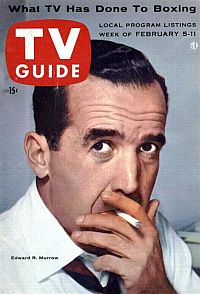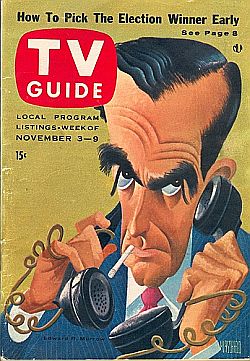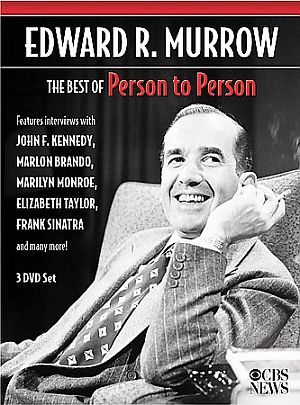
A three-disc DVD compilation of 32 'Person to Person' shows was released by CBS in 2006. Click for DVD.
Person to Person was created by the legendary newsman, Edward R. Murrow, a celebrity himself who first gained notoriety with his World War II radio broadcasts from London during that city’s bombing by the Germans. Following the war, Murrow moved his radio show, Hear It Now, over to television, calling it See It Now.
From his war days on, Murrow became known as a no-nonsense newsman who would take on tough, controversial subjects, including abuses of power.
In the early 1950s, when much of the nation was being terrorized by the communist witch-hunt of U.S. Senator Joe McCarthy, Murrow exposed McCarthy for the demagogue he was in a classic 1954 televised showdown. Yet Murrow also became well known for the success of Person to Person, an early version of “celebrity TV” and today’s hyped-up successors like Entertainment Tonight or Access Hollywood. With Murrow as host, Person to Person ran every Friday night from October 1953 to June 1959.
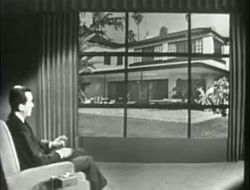 Edward Murrow at left as home of movie star Kirk Douglas is shown on studio screen, 1957. |
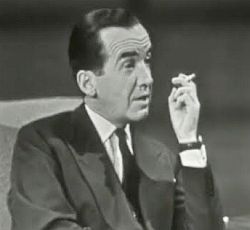 Edward Murrow interviewing guests. |
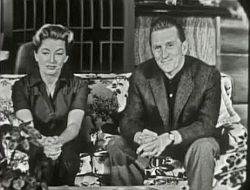 ...with Mr. & Mrs. Kirk Douglas, 1957. |
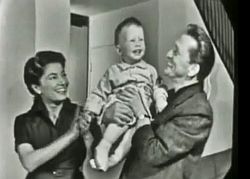 The Douglases with one of their children. |
The show’s format basically featured Murrow, cigarette in hand, visiting with Hollywood stars, TV celebrities, sports figures, authors, and politicians in various informal settings. Guests were typically shown at their homes or in other settings, and through the magic of televsion, were projected on a wall-size screen in the CBS studio with Murrow seated in an easy chair asking questions.
Using two to six cameras in production, the program usually opened in a celebrity’s home, with Murrow taking his viewers on room-by-room tours as he spoke with his on-screen guest. The range and variety of famous people Murrow interviewed was unprecedented for network television at the time. Among some of Murrow’s more illustrious guests were performers and actors such as: Frank Sinatra, Elizabeth Taylor, Sammy Davis, Jr., Lucille Ball, Marilyn Monroe, Liberace, Julie Harris, Mary Martin, Milton Berle, and Sophia Loren; authors such as Walter White and John Steinbeck; pianist Van Cliburn; boxer-in-training Rocky Marciano; former U.S. president Harry Truman; and former first lady Eleanor Roosevelt.
Other notable shows included his October 1953 interview with the recently married U.S. Senator John F. Kennedy and his new wife, Jacqueline Kennedy, a former Washington newspaper reporter. An April1955 session with the 31 year-old Marlon Brando came after Brando had starred in movie On the Waterfront, for which he won an Academy Award.
During one three-week period in 1957, Murrow interviewed political cartoonist Herbert Block, media market researcher, A.C. Nielsen, and Robert F. Kennedy, then Chief Council of the Senate’s Select Committee on Improper Activities in the Labor or Management Field.
In a 1957 interview with movie star Kirk Douglas, then at the peak of his film career, Murrow took his viewers on a tour of the Douglas home, with Kirk and wife showing off their tennis court, swimming pool, and lovely home, and one of their children. Then Murrow asks a typical “Person-to-Person” question: “Kirk, is all this part of the reason why you wanted to be a movie star?” To which Douglas replies:
“Well, you know, Ed, very seriously, I never even dreamed of being a movie star. My hope in life was always to be a Broadway actor. I’ve done about ten Broadway shows, but they were all flops. At least I was consistent. Then a friend of mine, Lauren Bacall, got Hal Wallis interested in giving me a screen test. I was a little frightened at first, I didn’t think I was the type. But then after another flop… I thought maybe I oughta give Hollywood a try. So I came out here, Ed, and I will say Hollywood’s been pretty nice to me.”
Murrow also interviewed Fidel Castro at one point. And while Castro’s appearance on Person to Person had the potential to alienate viewers — and that program did attract government criticism — Murrow survived. In fact, after Person to Person’s inaugural season, Murrow won an Emmy for the Most Outstanding Personality in television.
Show Biz v. Journalism
Still, Murrow and his show received frequent criticism in the press. Some called Person to Person aimless chatter with empty-headed movie stars. These critics argued — as Murrow himself would on more than a few occasions — that television programming demanded more substance and depth. Someone of Murrow’s stature, they suggested, should be doing more important things. Yet Murrow had initially thought the show might feature a wide variety of everyday working people and less privileged Americans, including blacks, Indians, farmers, and laborers.“Person to Person was an historical step to building the cult of personality in news programs.” But it failed to do that. He also believed the series could help “revive the art of conversation.” Yet the conversation that resulted on most shows was pretty thin, and even with politicians Murrow avoided the controversial. Celebrity and image proved to be the show’s more powerful appeal. “The program existed from the start much more in the world of show business than of journalism,” wrote David Halberstam in his book, The Powers That Be. The Museum of Broadcast Communications has stated that Person to Person “was an historical step to building the cult of the personality in news programs. The personalities were divided into two camps, with the entertainment and sports figures in one, and the second containing all others, including artists, writers, politicians, lawyers, scientists, and industrialists…”
In 1956, CBS acquired Person to Person from Murrow who was the sole owner. The show was a money maker for the network, providing a substantial profit; it ranked in the top ten network programs nearly every year it ran. Person to Person also made Murrow more of a celebrity than he already was, providing him with more leverage at the network — at least for a time. It also embroiled him in controversy and network in-fighting when some accused the show — at the height of the TV quiz-show scandal with its rigged outcomes and coached contestants — of deceit and dishonesty, claiming Person to Person‘s guests were also scripted and coached. While the controversy had its ill effects at the network, it did not appear to have injured Murrow publicly.By the Fall of 1959, Charles Collingwood, a Murrow associate since WWII, became the show’s host. Person to Person‘s ratings success translated to Collingwood, as the show continued to feed the public’s appetite for the celebrity interview. In 1961, Murrow left CBS after newly elected President John F. Kennedy asked him head up the U.S. Information Agency.
Although Edward R. Murrow is perhaps best known today for his prescient warnings about the potential dangers of television, he also had a hand through Person to Person in opening up television to its preoccupation with all things celebrity. At the time he ran the show, however, Murrow defended Person to Person. He believed that a variety of guests had value for viewers.“Television in the main is being used to distract, delude, amuse and insu- late us.”
– Edward R. Murrow, 1958 He noted that by interviewing prominent authors his viewers might be prompted to buy books and read more, or that a guest like pianist Van Cliburn could encourage children to take up the piano. But even before Murrow had left the show and CBS, his views on the potential downsides of television were stated quite emphatically in his famous October 1958 speech before the Radio-Television News Directors Association. In that speech, Murrow alluded to the rising power of television’s “elaborate structure of networks, advertising agencies and sponsors…” But his central message had to do with the potential misuse of television: “This instrument can teach, it can illuminate; yes, and it can even inspire, but it can do so only to the extent that humans are determined to use it to those ends. Otherwise it is merely wires and lights in a box.” A month later, in December, Murrow wrote in a TV Guide article that viewers must recognize “television in the main is being used to distract, delude, amuse and insulate us.”
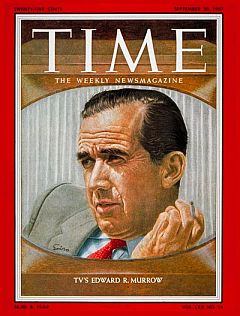
Edward R. Murrow on the cover of Time magazine, September 1957.
Nearly fifty years later, the debate continues on the “news-vs-entertainment” issue — which in Murrow’s day was focused more on how much money the broadcast networks were spending on each and how to keep news and entertainment separate from one another.
Today, with cable TV plus the internet and the “always-on” news cycle, separation of the two seems almost quaint, as news has increasingly become a form of entertainment. There is also the broader and more pervasive impact of TV- and web-aided celebrity on business, politics, and popular culture. Person-to-Person was a stepping stone in all of this, innocent perhaps, but part of the evolution nonetheless.
For those interested in the Person-to-Person contribution to this portion of television history, there is a good sampling of the show’s legacy on tape and DVDs. There is also a sampling of clips on line at Google, Yahoo, You Tube and various websites. One 2006 DVD set on the Person to Person series also includes a good sampling of the show’s interviews.
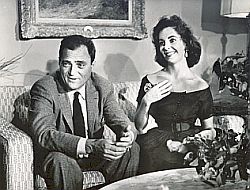
Liz Taylor and husband Mike Todd on 'Person to Person,' April 1957.
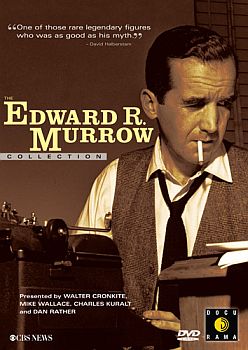
This four-disc DVD set from CBS News is available and includes some of Murrow's news broadcasts & interviews. Click for DVD box set.
Murrow The Newsman
Much more, of course, has been written about Ed Murrow the newsman — his years in radio, his reporting abroad, and his influence generally on news and TV journalism (see sources below). There are also DVD’s available on a number of Murrow’s news broadcasts and related shows, such as the one displayed at left. In 2005, Good Night and Good Luck, a Hollywood film produced by movie star George Clooney was released, focusing on Murrow’s famous 1954 confrontation with U. S. Senator Joe McCarthy. Clooney has also been interviewed about the making of this film by Charlie Rose on The Charlie Rose Show.
In mid-December 2011, CBS News announced it would launch new version of the Person to Person series, with co-hosts Charlie Rose and Lara Logan. Reportedly, for years CBS had dreamed about bringing back “a modern version” of the series. The new show, according to CBS, was planned to retain many of the elements of the original show’s format, with the TV hosts taking viewers into the private homes of singers, actors, directors, political leaders, and other newsmakers and celebrities. Two episodes of the new show aired in 2012. The first, on February 8th, featured interviews with George Clooney, Jon Bon Jovi, and Warren Buffett. That show attracted 5.9 million viewers, less than a third of those watching American Idol, for example. The second episode aired on November 23, 2012 (Black Friday), and featured Sean Penn, Alicia Keys and Drew Brees. Apparently, the first two episodes did not do well enough for the new show to become a regularly scheduled series.
For additional stories at this website dealing with the media and the news business see the “Media & Society” category page, or go to the Archive for other choices. Thanks for visiting — and if you like what you find here, please make a donation to help support the research, writing, and continued publication of this website. Thank you. – Jack Doyle
_______________________________
|
Please Support Thank You |
Date Posted: 7 May 2008
Last Update: 22 January 2020
Comments to: jdoyle@pophistorydig.com
Article Citation:
Jack Doyle, “Person to Person, 1953-1961,”
PopHistoryDig.com, May 7, 2008.
_______________________________
Sources, Links & Additional Information
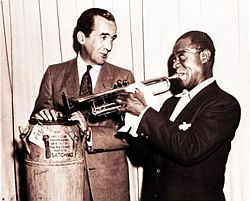
Edward R. Murrow with Louis Armstrong on 'See It Now', May 1953.
J. Merron, “Murrow on TV: See It Now, Person to Person, and the Making of a ‘Masscult Personality,’ Journalism Monographs (Austin, Texas), 1988.
Pete Martin, “I Call on Edward R. Murrow,” Saturday Evening Post , January 18, 1958.
“Edward R. Murrow,” Wikipedia.org.
Stanley Cloud and Lynne Olson. The Murrow Boys: Pioneers on the Front Lines of Broadcast Journalism, New York: Houghton Mifflin, 1997.
Alexander Kendrick, Prime Time: The Life of Edward R. Murrow, Boston: Little, Brown, 1969.
Joseph Persico, Edward R. Murrow: An American Original, New York: McGraw-Hill, 1988.Bob Edwards, Edward R. Murrow and the Birth of Broadcast Journalism, Hoboken, NJ: Wiley, 2004.
“A Conversation with Filmmaker George Clooney,” The Charlie Rose Show, October 14, 2005.
David Halberstam, The Powers That Be, New York: Alfred A. Knopf, 1979, pp. 139-143.
“Person to Person: Kirk Douglas (1957),” …She Was a Bird, June 22, 2011.
Lisa de Moraes, “CBS Exhumes Edward R. Murrow’s ‘Person to Person’ Celeb Interview Show,” Washington Post, December 15, 2011.
Brian Stelter, “CBS Is Reviving ‘Person to Person,’ Made Famous by Murrow,” New York Times, December 15, 2011.
“Edward R. Murrow: The Best of Person to Person – Sophia Loren Clip,” formerly posted at GoogleVideos, 2008.
“Person to Person with Senator John F. Kennedy, 1953″ (11:06), formerly posted at GoogleVideos, 2008.
“Senator John F. Kennedy on Edward R. Murrow’s Person to Person” (1953), YouTube (1:32).
“Person to Person Interview with Marilyn Monroe and Milton Green (magazine photographer) and Amy Greene,” YouTube.com.
“Edward R. Murrow: The Best of Person to Person – Liberace Clip,” formerly posted at Google Videos, 2008.
________________________________
